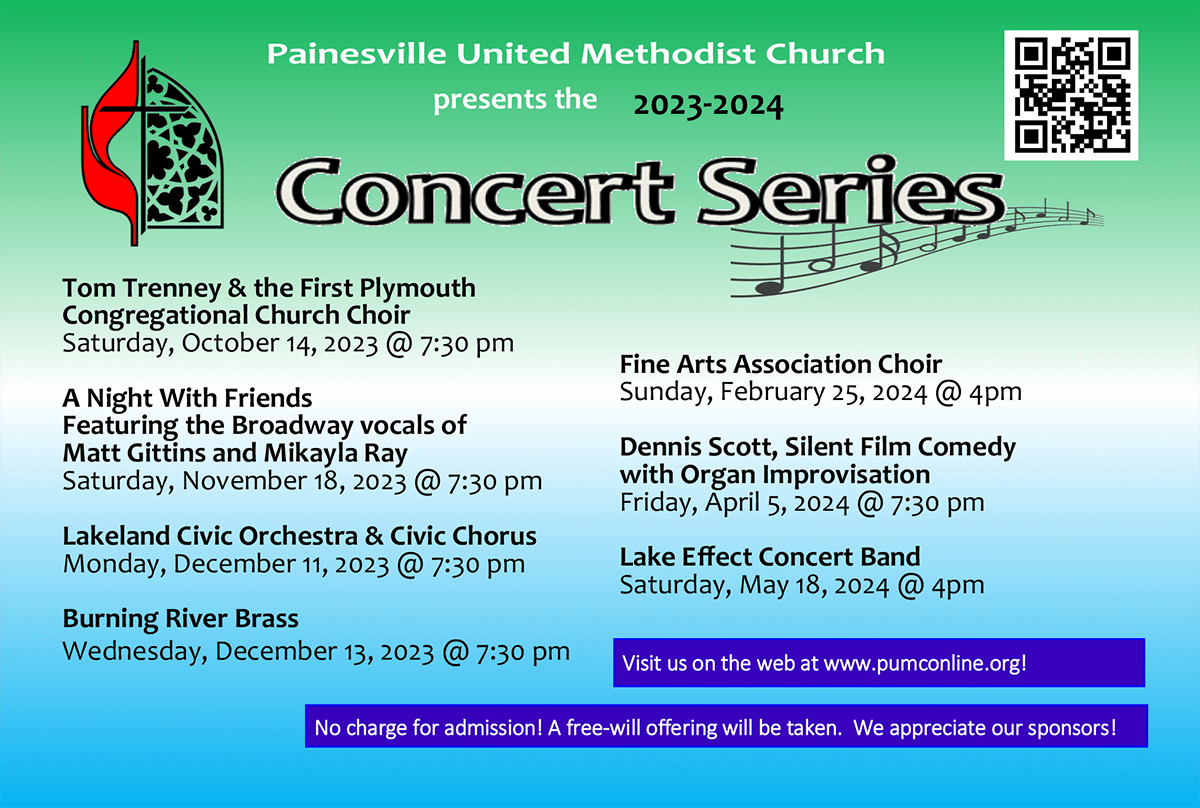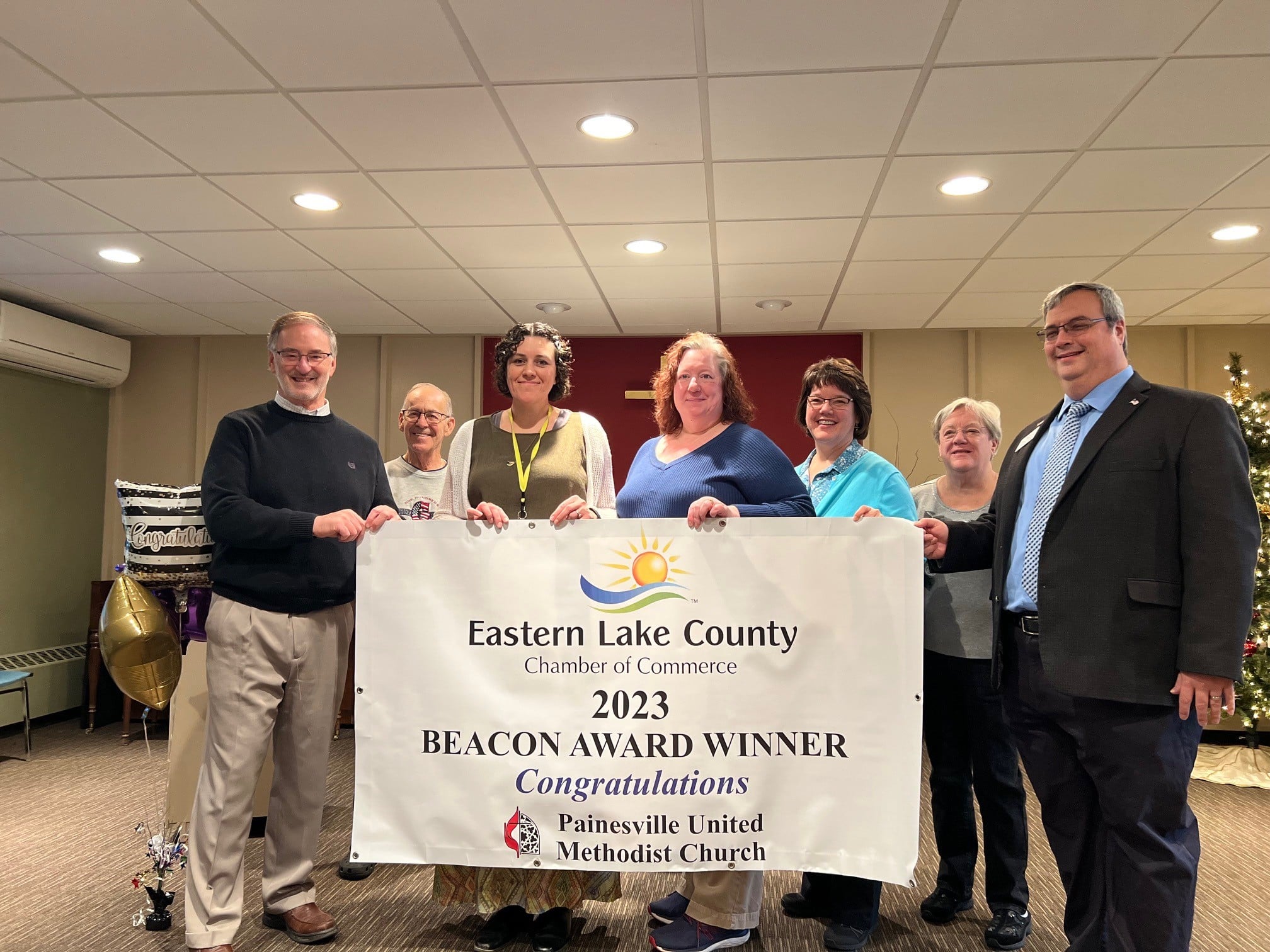Church History
Historical Details of the Painesville United Methodist Church Building
From the earliest gatherings in homes of small groups of Methodists to conduct their religious services, to the appointment by the Ohio Conference in 1818 of Mr. Ira Eddy as circuit rider preacher on the Grand River Circuit, to the construction of a Methodist meeting house on Liberty Street in 1822, and through years of changes and moving to different buildings, finally in the spring of 1873 construction was begun on this building located at 71 North Park Place in Painesville, Ohio. The lot, “suitably located on high ground in the center of the village on the north side of the village park,” was purchased from George and Sarah Steele for $10,000; and the contract for laying the foundation and cut- ting the stone for the building was given for $8,000.
Mr. Jacob Snyder was the selected architect. His design for the building incorporated ideas from the Metropolitan Wesleyan Methodist Church in Toronto, Canada for the front and exterior, while the Sunday School rooms and much of the interior followed the plan of the Akron Methodist Episcopal Church in Akron, Ohio. A description of the building by Mr. Snyder appeared in the October 23, 1873 edition of The Painesville Telegraph and contained the following details:
“This building, which in architectural style is designed to be decorated Gothic, and to be built of red brick, with stone dressings, has its foundation walls and ashlar* work now completed. Its greatest length, including the projections of buttresses, is 161 feet, by a width correspondingly measured of 80 feet. The plan of the building is symmetrical, having two towers upon the two front angles including the front vestibule between them; the main audience room centrally located; and the S.S. apartments at the rear. The portion of the building including the latter projects somewhat beyond the side walls of the central portion, thus producing an outline of plan similar to the letter T. Of the two front towers, the one is 18 feet and the other 16 feet square, having octagonal buttresses at their angles topped out with pinnacles corresponding with their size and form. The toppings out of the main walls of towers consist of gabled louvres, surmounted with parapets, and pinnacles smaller than those at the angles.” (Note: These towers were to have been surmounted by two iron spires, but ones that were placed upon the rear of the building were blown down, so that ornamentation was omitted from the towers.)
*The term “ashlar” refers to large, rectangular blocks of masonry.
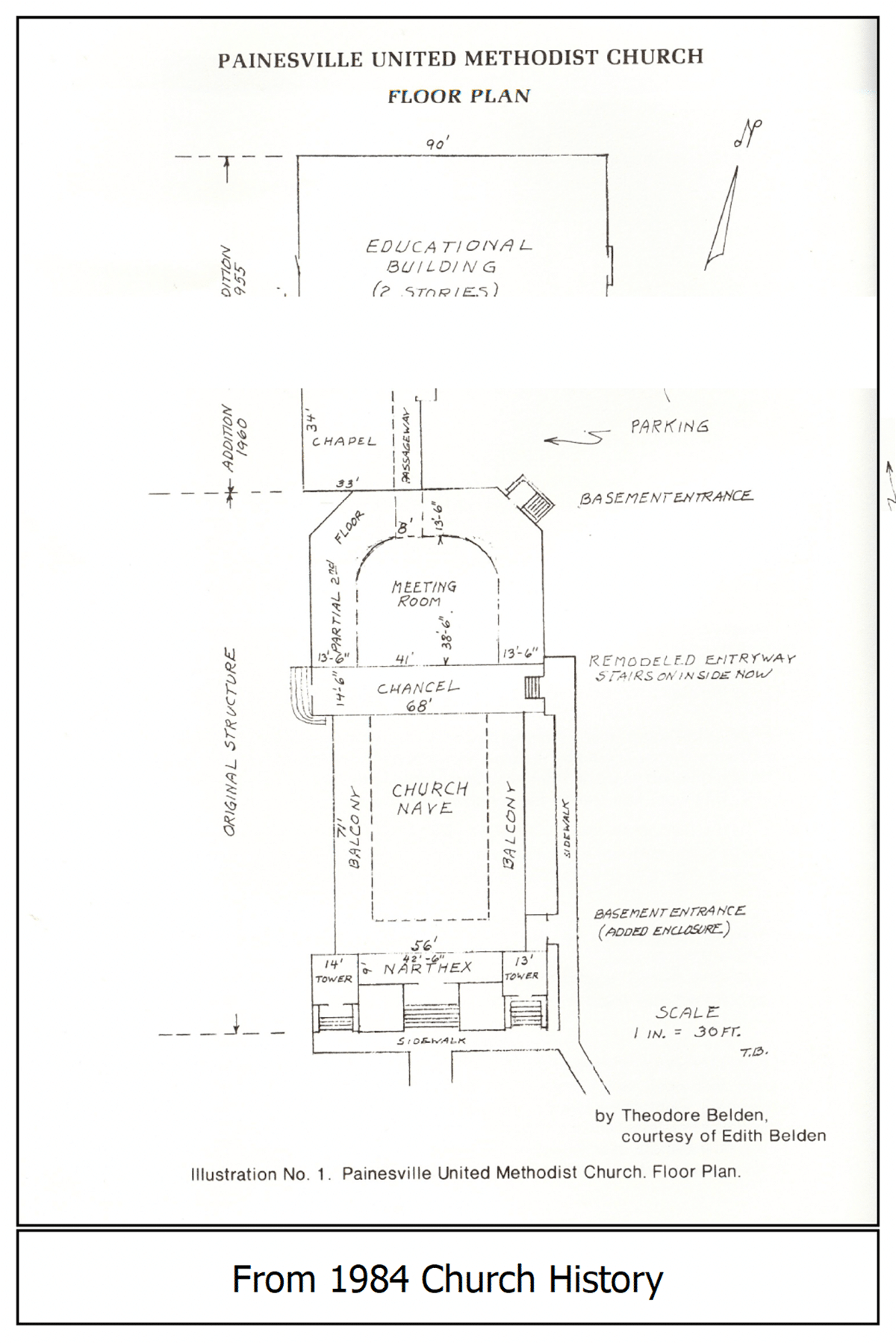

“In the center of the front is the principal doorway, with columns, bases, carved capitals, Gothic arch with carved key and springing stones, and crocketed finial. Each of the front towers has also an entrance, similar in design to the central. Besides the three front, there are also two side entrances, accommodating the S.S. apartments and the rear of the audience room.
“The window distribution of the entire building is liberal, both for architectural effect and ample light. The large front window is Gothic, having a height of 24 feet and an inscribed circle of 20 feet in diameter, about which it is formed. Two windows of similar design are located above the side entrance doors, extending into the gabled walls, thus serving to light the upper and rear vestibules.
“The main audience room, exclusive of vestibules and organ loft, is 56 feet by 70 feet; and has a continuous gallery, raking down from its general level to that of the choir at the rear of the peaker’s platform.
“The main S.S. room, exclusive of its complemental apartments, is 41½ ft. by 45½ ft., and in outline is somewhat more than a semipolygon – from the sides of which are projected two stories of seven classrooms, or in all fourteen rooms. These are connected with the main room by folding sash doors. In height the central room extends somewhat above the flat pitched metal roof of the radiating classrooms, thus admitting its being lighted by clear story windows, which are alternated segmental and Gothic, and are located in the polygonal sides. As many of the latter as contain the Gothic windows are gabled, having their roofs intersect the absidal roof of the central room. The latter roof is finished against the rear wall of the main building. The ceiling of the main S.S. room is vaulted and that of the main audience room inclined from the sides to the center.
“The lateral extremities of the space occupied by the singers’ gallery and organ loft serve on the main floor level and vestibules to accommodate the S.S. apartments and the rear of the audience room. Here are also located the two rear stairways, affording access to both the main audience room and S.S. room galleries. The latter is designed to secure communication with the upper tier of radiating classrooms; and in plan it corresponds with the contour of the main S.S. room, … thus communicating with the vestibules.
“The stone dressings of the interior are wrought out of Amherst stone, and are freely distributed throughout the brick work, producing a pleasing contrast. The woodwork of the interior is designed to be chiefly black walnut, neatly finished. And the usual decorations of fresco-painting and stained glass, in structures of this class, are contemplated.
“Provision has been made by means of air towers, at all times, to be able to command an abundant supply of fresh air, and to extract the impure as well. The cellar is sufficiently ample, in every particular, to admit its being fitted up with basement apartments for social purposes. It is designed to heat the building by steam, chiefly upon the indirect principle.
“In this church enterprise hardly anything has been omitted to be considered that would in any way contribute to the comfortable accommodations of a church and S.S. community, both as it regards its adult and youth population.”
In a dedication ceremony attended by church members and interested people from the community, the cornerstone was laid on a beautiful fall day, Wednesday, October 15, 1873. This stone, which had been contributed by the builder and with lettering done by townsman William Doran, holds a box which contains the following items:
- Early records of the church and society;
- Names of the Presiding Elder of the district, the pastors, Superintendent of the School, Trustees, Class Leaders, and Stewards of the M.E. Church of Painesville;
- Names of the various churches in Painesville, with their present pastors;
- A list of subscribers to the building fund, including the Sunday School scholars;
- Copies of the Bible, Hymn Book, Minutes of the Annual Conference, and various periodicals and newspapers of the church;
- Copies of The Painesville Telegraph of the current week, and other county papers;
- Catalogue of Lake Erie Seminary, and other documents.
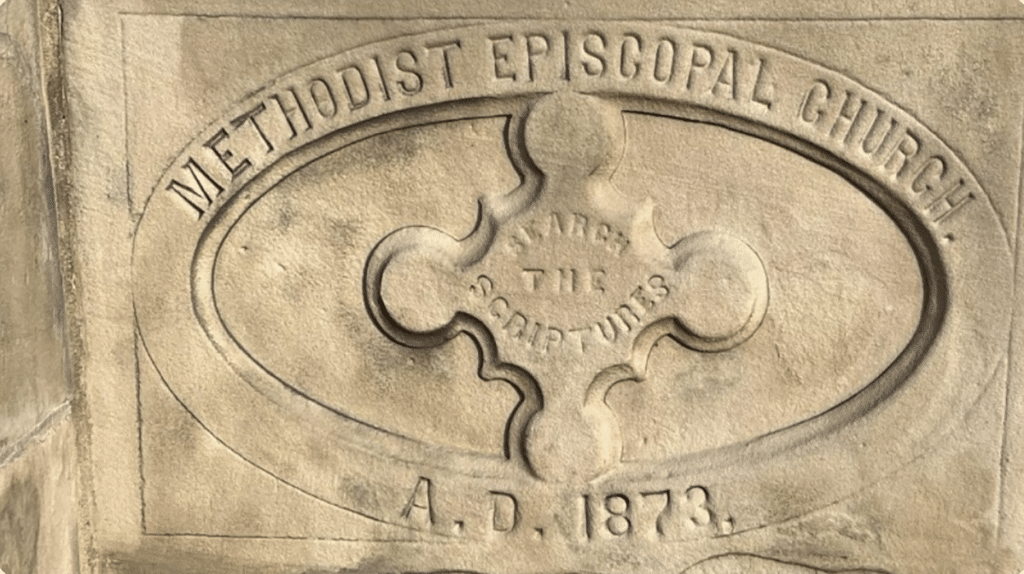
from debt in 1897. The Rose Window, located at the front of the church, consists of 1,371 carefully selected and cut pieces of stained glass and measures 24 feet wide and 20 feet high, one of the largest in the country. Its cost of $300 was donated by the Young People’s Society. In the center is a 7-pointed star known as the Mystic Star and representing the seven gifts of the Holy Spirit.
Additional symbolism is evident in the ten tall stained glass windows on each side of the Sanctuary, designed and created by Douglas Phillips. As described in the 1984 history of our church, the windows are as follows:
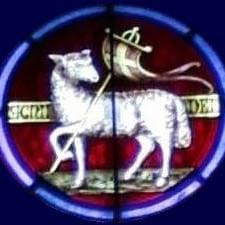
Agnus Dei or Lamb of God
This is the symbol of Agnus Dei or Lamb of God. Out of the Hebrew sacrificial system, Christian application made the lamb as the symbol of Jesus Christ. John the Baptist said, “Behold the Lamb of God who takes away the sin of the world.” The lamb, one of our earliest symbols, was frequently used in Roman catacombs. In symbolism, the Suffering Lamb is shown with a cross, the Triumphal Lamb with a waving banner, and the Enthroned Lamb depicted seated on the Book of Seven Seals mentioned in the Book of Revelation. Our window portrays the Lamb as both the Suffering and Triumphant Christ, with cross and banner. This is one of the greatest of all symbols used in Christian art to represent the Son of God. The money for this window was donated by the children in the Sunday School Primary Class.
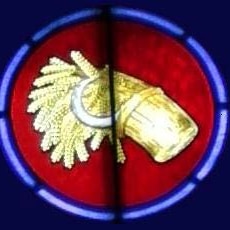
The Sheaf
The sheaf of wheat is a symbol of God’s bounty and goodness. As God enables man to gather a harvest from the earth, He makes it possible to reap a spiritual harvest as well. St. Paul said, “Whatsoever a man sows, that will he also reap.” As pictured here the sheaf of wheat with a sickle is a symbol of the harvest and the autumn of life. Along the sides of the window are wheat and tares – the good crop and the weeds. Matthew relates one of the parables of Jesus, which ends, “Let the wheat and tares grow together until the harvest; and at harvest time I will tell the reapers, ‘Gather the weeds first, bind them in bundles to be burned, but gather the wheat into my barn.’”
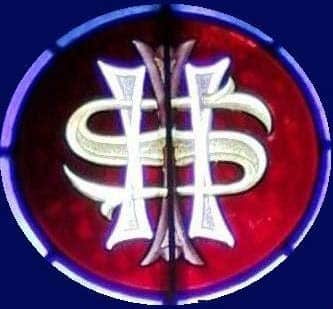
IHCOYC
Within this inset we see one form of the sacred monogram IHCOYC. Through the years, as knowledge of Greek became rare, the Greek C was changed to the Latin S, so the monogram HIS is used more often instead of IHC. Our window shows an interesting intertwining of IHS as the monogram evolved in the Middle Ages and representing “With This Sign.”
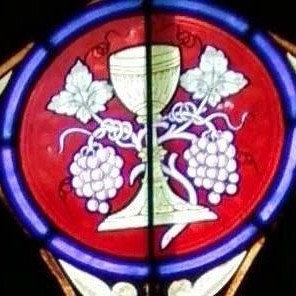
The Chalice
The chalice, or cup, is a beautiful reminder of the cup which our Lord took and blessed and gave to his disciples at the Last Supper. Jesus said, “This cup is the new covenant in my blood. Do this as often as you drink it, in remembrance of me. For as often as you eat this bread and drink the cup, you proclaim the Lord’s death until he comes.” Pictured with the chalice there are grapes and leaves on a vine representing not only the source of the communion wine but also Christ and his disciples. In the parable of the vine, Jesus said, “I am the vine, you are the branches. He who abides in me, and I in him, he it is that bears much fruit, for apart from me you can do nothing.”
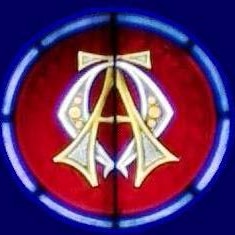
The Bible
It is easy to understand the symbol of the Bible, the sacred book accepted by Christians as divine authority, the Word of God. Note that the Bible is pictured as open – open to all who will hear, study, believe. Translations of the Bible, or portions of it, have been published in more than a thousand tongues.

The Crown
If the crown appeared alone it would be used as a symbol of the kingly office of Christ. “For He is Lord of Lords and King of Kings.” But here we have the symbol of the Crown and Cross, which stands for a reward to those who are faithful unto death. In Revelation we read, “Be faithful unto death and I will give you the crown of life.” In the arm of the cross appear the letters INRI. These represent the Latin words, “Jesus of Nazareth, King of the Jews.” According to the book of John, Pilate caused a title of mockery written in Hebrew, Latin and Greek to be placed on the cross saying, “Jesus of Nazareth, King of the Jews.”

Interwined
Intertwined are the first and last letters of the Greek alphabet – Alpha or A and Omega or O. They stand for the beginning and end, the first and last. They are used as a monogram to indicate that Christ is an eternal figure and symbolize the everlasting nature of the divinity of Christ.

The Anchor
The anchor as a symbol of hope was used in the catacombs by persecuted Christians. The anchor pictured here is a combination of anchor and cross symbolizing both hope in the life eternal and salvation from sin through the Saviour’s death and resurrection.

The Dove
The descending dove represents peace and purity. It is the most familiar symbol of the Holy Spirit. Pictures of our Lord’s baptism always carry this symbol. The Gospels of Matthew, Mark, and Luke all mention the Holy Spirit descending like a dove upon Jesus as he came out of the River Jordan, following His baptism in its waters.

Six Pointed star
The number of points in a star is significant in Christian symbolism. In this window we have the sixpointed star or creator’s star formed by superimposing one triangle on another. This six-point star symbolized the six days in which God created the world. Sometimes it is used as an emblem of God the Father, the six points referring to His attributes: power, wisdom, majesty, love, mercy, justice. A triangle, of itself, represents the Trinity: Father, Son, and Holy Spirit. The use of two triangles in the Creator’s star doubly emphasizes the holy Trinity in the process of creation.
Included in the windows of the Sanctuary are many other symbols. There is the rose symbol in the round, various colored medallions near the top of each window. The rose may, on one hand, represent the promise of a Messiah for, as Isaiah foretells, “The desert shall rejoice and blossom as a rose.” But the rose also may represent each of the following: love, our Lord or His nativity, paradise, beauty, and Mary the mother of Jesus.
Then there is the passion flower, used as a symbol of the suffering of Jesus, and the bursting pomegranate, a symbol of Easter and the resurrection of our Lord and thus signifying the hope of new life. A small three-petal motif repeated over and over is another symbol of the Trinity, as is the Fleur-de-lis in the windows over the front stairways. Certainly symbolism has played a very important part in the proclamation of Christian faith. From the days of the very early church to the present, symbols have served to bring Christian ideas home to the heart of man.
Throughout subsequent years, many aspects of maintenance and re- decorating were carried out on the church building. In 1905, the original carpet was laid at a cost of $700. In 1913, the unfinished basement was excavated; and a social hall, including a stage, kitchen, and serving room, were built. A central heating system replaced the original combination of two furnaces and six coal stoves that had to be tended by the women of the church, and an electric lighting system was installed to replace the original gas illumination – all for the cost of $8,000.
In 1923, a contract in the amount of $9,308 was given to construct the balconies in the Sanctuary; followed by a contract at a cost of $1,630 for new oak pews whose ends were stained walnut to match the rest of the woodwork.
The 1929 depression brought many hardships to church members, and necessary funds for maintenance and upkeep of the church were hard to raise. But the church needed redecorating, so the members rallied and contributed both labor and materials. They worked whenever they could, day or night, and did the job without creating more debt. In 1935 the old tubular organ was rebuilt and electrified. Chimes were added with tower amplification so they could be heard in the downtown Painesville area.
In 1946 the church was redecorated again at a cost of $8,000. In the early 1950’s it became evident that better facilities were needed to accommodate the Sunday School program. There was an urgent and imperative need for an additional building. With this goal in mind, the members began a three-year fund-raising campaign that culminated in raising $150,000; and a contract was awarded in February, 1954 to the William Voegtler Construction Company to build a two-story educational building on the vacant space to the rear of the church. It was completed at a cost of $144,000 and dedicated on September 15, 1957.
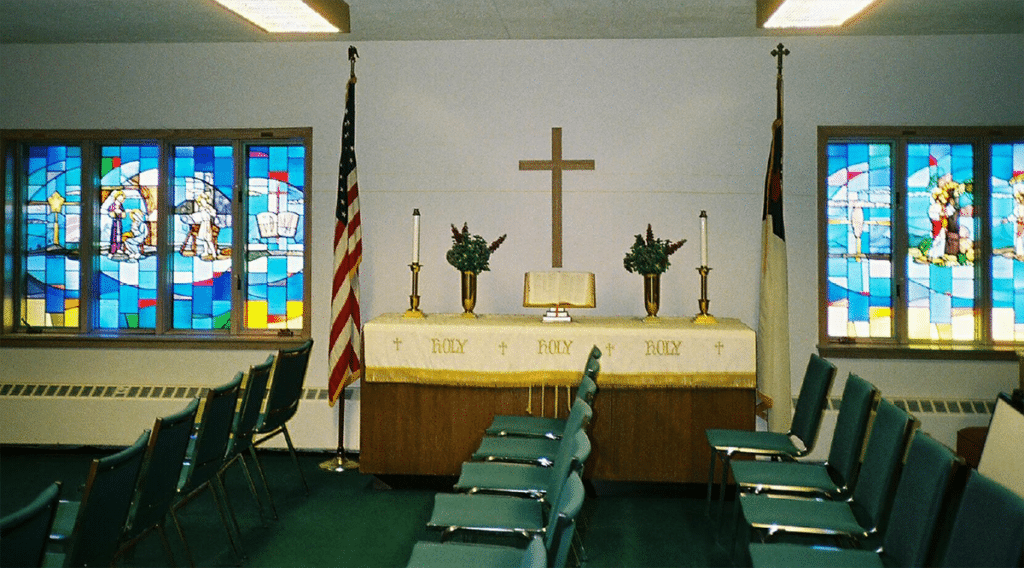
Soon thereafter, in 1961, a building committee was formed to study the need for alterations to the main church building and provision for a connection between the two buildings. A Chapel with stained glass windows was incorporated into the design for this connecting hall. Windows were designed and built by the Phillips Stained Glass Studio, Inc., of Cleveland.
The design of the Chapel windows combines traditional and contemporary in a series of vignettes set in a field of irregular rectangles of blues and greens accented with violet; the figures are stylized to suggest the contemporary. The smaller side-by-side windows on the left wall as you enter the Chapel are devoted to symbols of the Saviour – on the first the Chi Rho, an anchor symbolizing Jesus Christ the anchor of the soul, and the three nails symbolizing the crucifixion; and on the second an empty cross representing the resurrection, another form of the Chi Rho, and the IHC symbol.
Going around the Chapel to the right, the next four windows form the story of the Nativity and Christ as a young man. The first of these windows shows a landscape and the Star of the Nativity; in the background can be seen the three Wise Men on their way to Bethlehem. The second features the Nativity; the third shows Christ as a young man in Joseph’s workshop holding an ax in His arm while He studies religious writing and teachings. The fourth of this series of windows contains a cross rising from behind the open Bible with the letters VDMA, which stand for the Latin phrase “Verbum Dei Mani Aeternae” – “The word of God endures forever.”
The four windows to the right of the Chapel altar relate to the adult Jesus as Teacher and Saviour. The first features the Hand of God the Father shedding blessings on earth. The next window shows Christ knocking at the door; the landscape behind this one then flowing into the third of this series, which features Christ as a Sower. The fourth window in this series contains the Dove of the Holy Spirit.
The glass used in these Chapel windows is called antique. It is handblown glass made the way glass was done during the Middle Ages. Using the mosaic approach in designing these windows, a change of color was achieved by using a different piece of glass. Any detail, such as hair tone and some parts of the halo, was fired on with special paint to such a temperature that it actually became a part of the glass and is permanent.
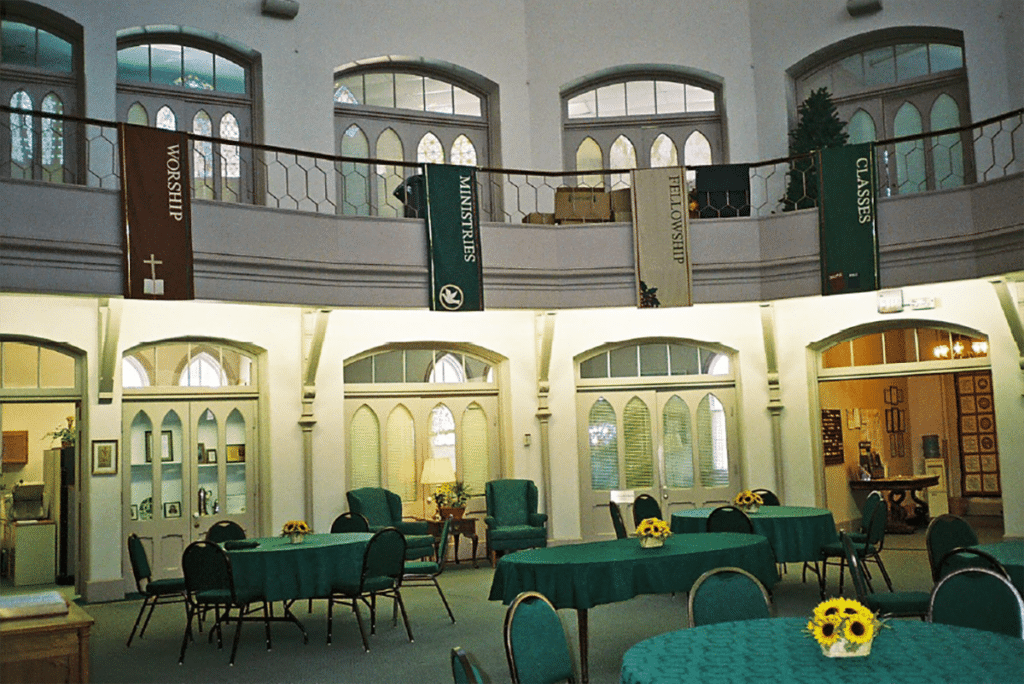
At the time of constructing the Chapel and connecting hallway, new doors were installed in both the original side entrance and the Chapel entrance. Each of these doors contains stained glass in the form of a cross. The left hand door symbolizes redemption through Bible teachings found in the Old Testament and the Law of Moses. The head and the left and right arms of the cross form the Trinity, with the Father’s hand on the left, the Chi Rho symbol of the Son at the head, and a dove representing the Holy Spirit on the right. At the base of the cross are the two tablets symbolizing the Old Testament and the Law of Moses. Above this symbol in the window is a globe surmounted by a cross, symbol of the triumph of the gospel.
The window in the right hand door symbolizes redemption through the Church based on Methodist teachings and the New Testament. The left and right arms symbolize two sacraments: baptism as shown by a shell on the left and communion on the right represented by chalice and host. These two sacraments are the physical aids of the Church to help the Christian achieve redemption and salvation as shown in the center panel by the ark with the cross behind it. As a foundation for this we have the teachings of the Church symbolized by a church on a hill in the bottom panel. The missionary spirit of the church is symbolized by the ship in the head of the cross.
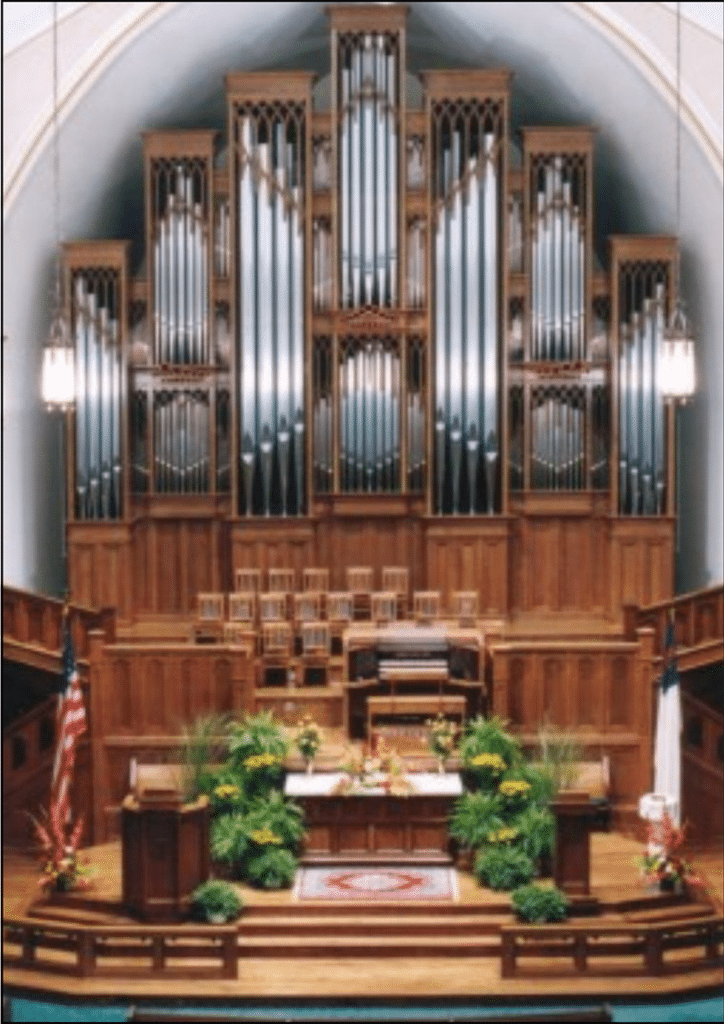
A three-year capital fund program begun in 1971 raised approximately $58,300. With this money, the organ was redesigned and rebuilt at a cost of $27,000, a new gas furnace was installed, the Circle Room and church parlors were re-carpeted and redecorated, the church Sanctuary was painted, the Rose Window was covered with a protective acrylic cover, and the worship center of the church was enlarged. With the completion of these improvements, a Sesquicentennial celebration service was held at the church on November 1, 1971.
In 1981 another capital campaign successfully raised money to replace the original 107-year-old slate shingle roof with asphalt shingles underlaid with 30# felt, to provide protective acrylic covers for the stained glass Sanctuary windows, to repair and paint the metal and woodwork on the towers, and to care for other general maintenance and upkeep details.
Church member William Parsons volunteered to remove, disassemble, re-lead, and replace needed portions of all the stained glass windows over a five-year period from 1983-1988. In 1992 he continued his stained glass work by creating three windows in the kitchenette area between the Sanctuary and the Circle Room.
Through 1990, many ongoing maintenance repairs were completed repainting, replacing windows, waterproofing, and necessary replacing of bricks in the exterior of the church. In addition, the education building was covered with rubber roofing material, electrical rewiring was completed, and Italian marble tiles were installed in the narthex entry way at the front of the church.
In 1991-1993, an extensive restoration program was carried out in the Circle Room and Sanctuary. The choir and organ areas were reconstructed to to accommodate the new Schantz pipe organ, a gift given in memory of Edna Cope Quine. Walls were repainted and new carpeting installed, new pew cushions were made, and the ceiling replaced. A new audio sound system and booth were installed to enhance the church’s continuing broadcasting of Sunday services over the local radio station. Exact replicas of original doors and woodworking were manufactured and installed. The reredos that had been inserted in the Sanctuary in 1971 was removed and placed in the Circle Room. A part of the restoration at this time included the replacement of the front steps with granite slabs that had been part of the old Cleveland Press newspaper building in Cleveland. The church celebrated its restoration efforts with its 175th anniversary in 1995.

All of the restoration work culminated in 1998 with the addition of our church building into the National Register of Historic Places, largely through the research and writing efforts of church member Marcia Parsons. The building had previously been accepted into the Lake County Historical Society listing of historic sites.
A strong windstorm in 1998 caused the spire from the upper tower parapet to lean toward the ground. Consequently, yet another capital campaign was held that raised funds to have both towers rebuilt and repaired in 1999. A new and thicker acrylic protective cover was also installed over the Rose Window. All of these efforts cost approximately $236,000.
In 2001, the kitchen next to the social hall was renovated and modernized with new equipment, new cabinets, new flooring, and new painting. The cost of $63,000 was aided by a donation in memory of Audrey Cole for whom the kitchen was renamed. New complete dinnerware settings were also purchased.
A few years later, Fellowship Hall itself was gutted and redecorated. The old side benches were removed, new walls and flooring put in, support columns covered, and decorative glass in the window wells added. Additionally, a corner room was created for storage. Before new tables and chairs arrived, however, heavy rains that caused severe flooding of the Grand River in the City of Painesville, also “uncovered” a previously undetected defect in the west wall foundation of the church, thus causing extensive damage to the remodeled hall. Once the foundation wall had been repaired, the new flooring and some of the new walls also had to be replaced. With the final completion of this remodeling, Fellowship Hall was renamed Parsons Hall in honor of Marcia and Bill Parsons.

Through the years, the devoted stewardship of church members has provided the vision, the talent, the labor, and the funds to maintain and enhance this beautiful and historic building. We have been blessed.
White Gift Service
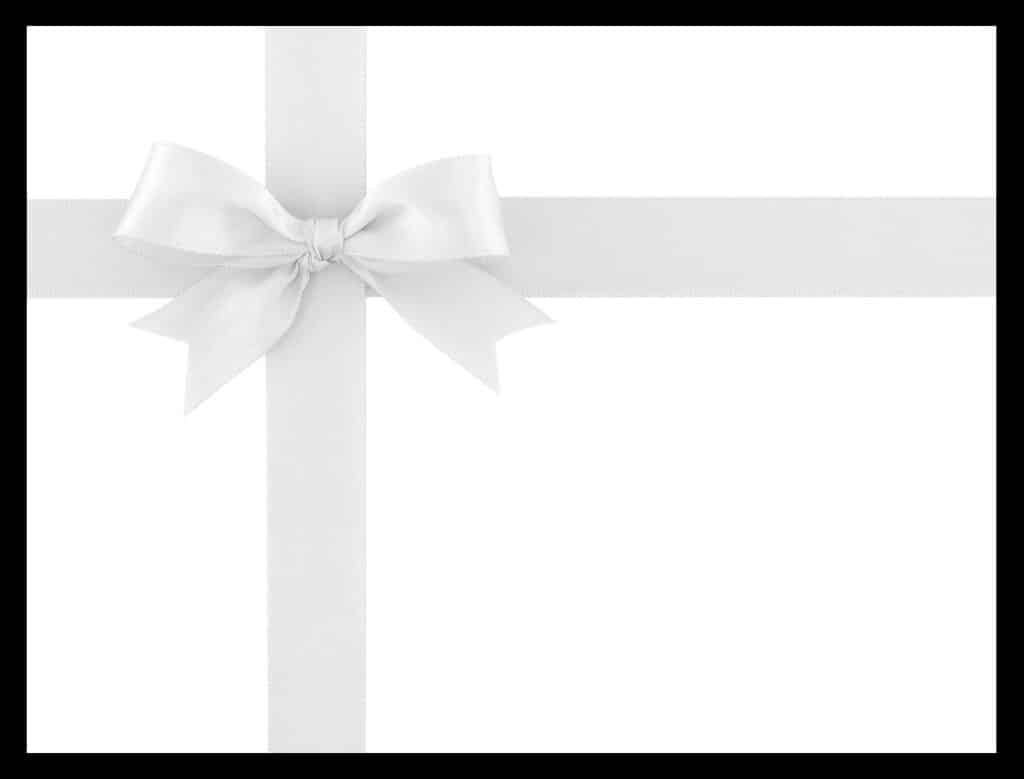
In 1904, the minister’s wife, Anna M. Winters, came across an old legend about “The King’s Birthday,” which told of a celebration where white gifts were brought before the king to show loyalty and love, but were wrapped in white paper so that both humble and extravagant gifts would be received with equal edification. This set her thinking – since Christmas was the observance of Our King’s birthday, why couldn’t a similar celebration be done with gifts to the church in honor of the Christ Child. This was the basis of our White Gift Service, the first of which was held right here at PUMC and over the many years since has been adopted by hundreds of churches around the world!
The original proposal for this service was presented to the Official Board of the church and then to Sunday School teachers and officers; the idea was enthusiastically endorsed by both groups. The initial plan noted that people are blessed individually with different gifts, and so the church body could offer not only gifts of Substance but also gifts of Service and Self. The students were asked to make a definite pledge of any of these contributions, sign it, and place it in the white envelope as their gift. At the first service, the envelopes were collected and emptied into a large new and shiny dishpan, and were found to total $300 when calculated afterward – or the 2022 equivalent of $10,045!
Each subsequent year brought new symbolism to the service including all church members. In the sanctuary a platform was usually draped in white with a green tree on each side, as the original legend said the king had done. At the proper time, white curtains were parted to reveal a large white cross. Then, depicting the nativity story in song and pageantry, shepherds and then three wise men came following the star to present their gifts while the hymn “We Three Kings of Orient” was sung. After the wise men arrived, those in the church wishing to make a gift brought their pledge card to the altar. Over the years this portrayal has been adapted based on changing needs throughout the life of the church, but has remained true to the original intent – to invite the congregation to commit themselves in self, service, or substance in honor of the birth of our Savior!
In 1944 our organist Ruth Zearfoss Herman introduced “The March of the Wise Men” to the procession during this service. The song has been played throughout the years by succeeding organists for each White Gift service, and depicts the story of the Wise Men as they journey to Bethlehem. The piece starts out with just organ pedal work, which represents the plodding of the camels carrying the Wise Men. Throughout the piece you can hear the Zimbelsterns on the organ, which represent the star over Bethlehem continuing throughout the entire piece. All of this gradually gets louder as the Wise Men approach Bethlehem. As the herald of the trumpets on the organ join in, the Wise Men have arrived, and at the very end you will hear only the star.
In 2023 we celebrated the 150th anniversary of our historic building right here at 71 N. Park Place, and in so doing presented a re-enactment of our PUMC-original White Gift service during our January 8th worship services as we celebrate the Wise Men finding the newborn King! As you reflect on your journey to the Savior, we invite you to consider ways in which you can be a part of the life of the Painesville United Methodist Church through self, service, and substance.
Susan B Anthony & Women’s Rights Convention
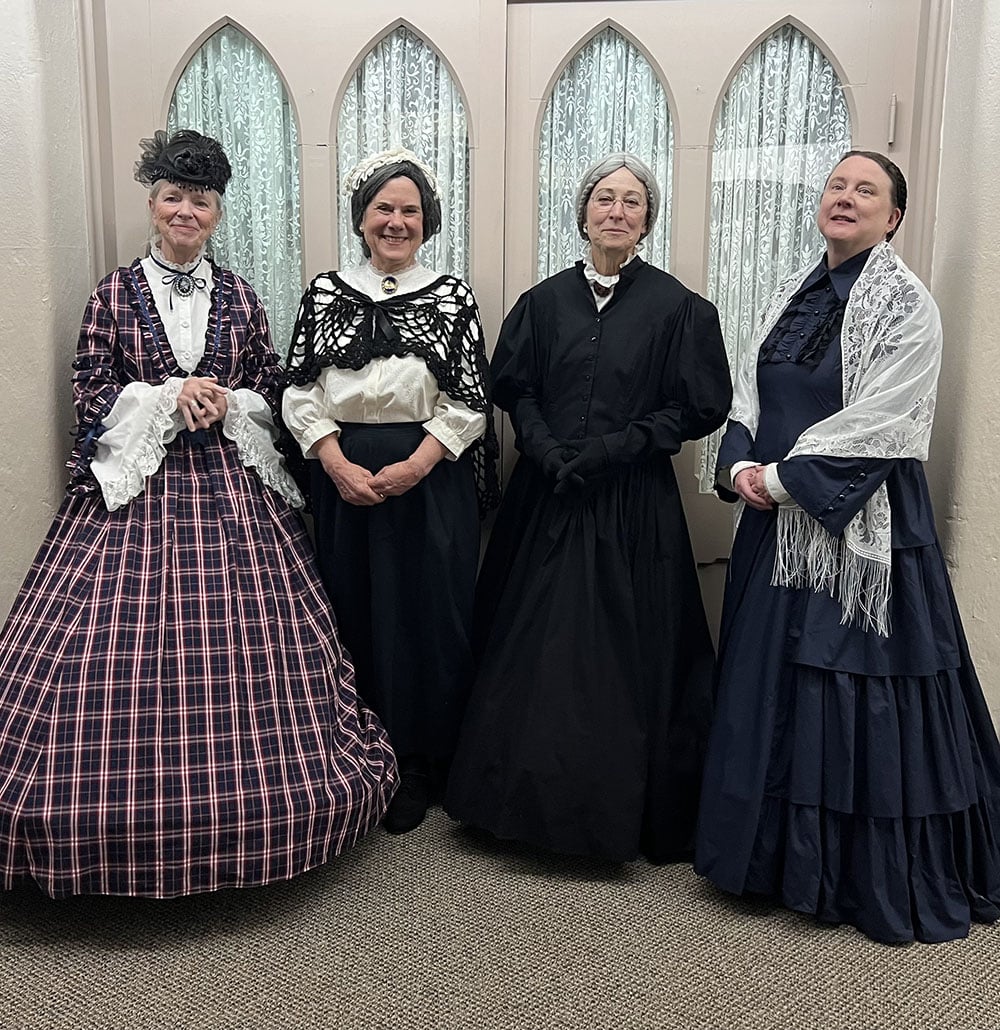
PUMC actually hosted a Women’s Suffrage Convention during a time when so many churches would have (and did!) objected to women being anything besides wives, mothers, and possibly teachers. Susan B. Anthony was actually in this building in 1885 advocating for equal rights for women! Alongside Ms. Anthony were also Lake Erie Seminary (now Lake Erie College) president Dr. Mary B. Evans, Helen Gougar (a female lawyer before women were ever allowed to vote!), and Painesville’s own Frances Jennings-Casement* (who set up the Equal Rights Association of Painesville in 1883). These ladies were in this space to promote the rights of women, along with the representatives of over 150 women’s rights organizations at that time! We were delighted to be able to work with Lakewood-based Women In History, a group dedicated to bringing historic characters “to life” in the most accurate way, to re-enact a portion of the 1885 Women’s Rights Convention during our 2023 Sesquicentennial Celebration. We are proud of our heritage and long-term support of equal rights here at PUMC!
*At the time of our re-enactment we were unable to experience Ms. Casement as a part of our program. However, we were delighted to welcome the character of Rev. Dr. Olympia Brown, the first female to be recognized in the United States as an ordained minister. Rev. Dr. Brown did spend significant time in Ohio and some time in Cleveland generating signatures for a petition of women to own their own homes, property, etc; however, she was never actually inside PUMC as far as we can tell. We were delighted to experience the re-enactment of her character during our Women in History weekend because Rev. Dr. Brown played such a significant role in women’s history and in the history of women in church leadership roles.
